7 Reasons You Need to Watch The Shadow
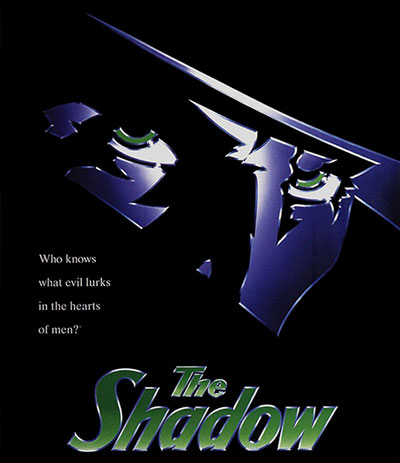 |
Russell Mulcahy’s 1994 The Shadow was one of the many post-Batman superhero films that never quite clicked with the public, but for my money, it deserved to find an audience. Now available on a spiffy-looking Blu-ray from Shout! Factory, it’s ripe for rediscovery. Here’s why.
1. The Shadow Predates Batman by a Decade.
 |
The Shadow stars Alec Baldwin as Lamont Cranston, a cocky playboy who uses his wealth to fight crime as a masked alter-ego in a sprawling metropolitan city. Which is clearly a total Batman ripoff (why can’t Hollywood come up with any original ideas?), but for the fact that the character of the Shadow debuted on the radio in 1930, and then in print in 1931, while Batman didn’t appear until 1939.
Obviously, history declared Batman the victor, but there’s still a clear lineage, and the Shadow even came out of retirement in 1973 to make a guest appearance in his successor’s comic…
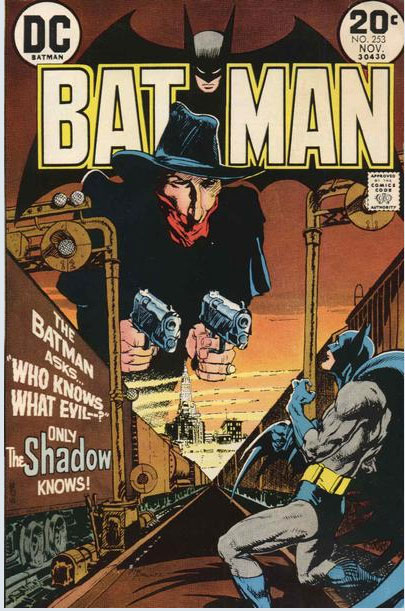 |
…and get his due props.
 |
(Sidenote about the 1934 magazine cover at the top of this entry. While the Shadow was clearly a proponent of the Second Amendment, that NRA logo is not for the National Rifle Association, but rather the National Recovery Administration, one of President Roosevelt’s New Deal programs to revive the economy during the Depression.)
As you may have noticed, the Shadow has quite the honker. Which brings me to my next point about The Shadow as movie:
2. It’s Faithful to Its Source, Including the Nose.
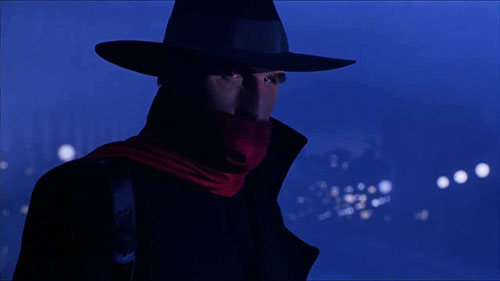 |
Oh yeah, they keep the schnozz. Not all the time, mind you; it only appears when Cranston becomes the Shadow. In addition to ass-kicking, his primary ability is hypnosis, aka “to cloud men’s minds” and become invisible, the better to facilitate the aforementioned ass-kicking.
Otherwise, he’s plain ol’ Alec Baldwin in his hunky prime.
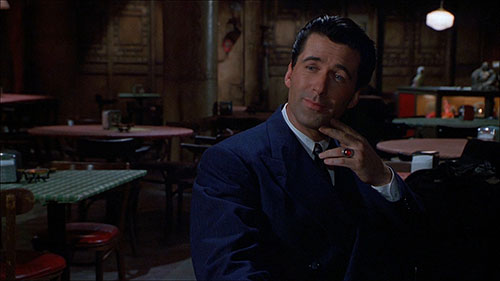 |
For that matter, when he’s in ass-kicking mode but no longer necessarily needs to cloud men’s minds or be otherwise stealthy, the nose and attendant brow also go away.
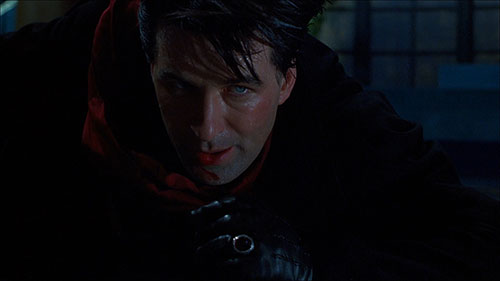 |
Why even bother with it, then? Why go to the trouble to include a detail that nobody under 50 would have likely cared about in 1994, let alone the all-important 18-45 demographic that the film largely failed to attract? Because they could, that’s why. Director Mulcahy and screenwriter David Koepp were determined to evoke the 1930s version of the character as much as possible, and that was part of it. And there’s no explanation given, either; it’s just a thing that happens, I respect them for not bothering to spell it out. (One of my personal theories is that it’s a phonetic play on the Shadow’s motto: “What evil lurks in the hearts ofmen? The Shadow knows.” Geddit? “Nose” sounds like “knows.” Yeah, that must be it.)
3. It’s Set in 1930s New York.
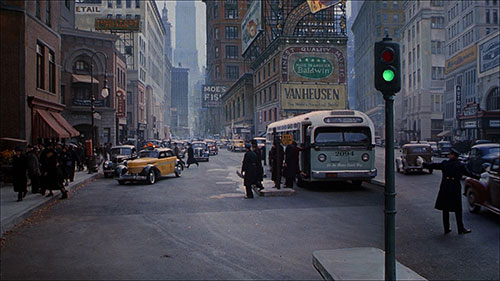 |
Though it continued on in various formats in later decades, the character of the Shadow is very much a product of Depression-era America, at least in terms of the public’s fascination with masked crimefighters. The 1994 film is set in period-specific New York (not Gotham City or Metropolis or any other fictional town), in all its art-deco glory. There also plenty of gliding shots through the definitely-a-model city, and those always make me happy.
In the included documentary, Russell Mulcahy uses the word “sumptuous” to describe the production design a few times, and it’s an apt description. If you’re a sucker for the look of 1930s New York like I am, it’s just a very tasty movie. While there’s some CGI, the effects are mostly optical and/or practical, which fits the setting.
 |
However, what digital effects there were required the film to be shot in regular 1.85:1 rather than 2.35:1 anamorphic widescreen, since the effects companies weren’t sure yet how to do the digital effects in anamorphic. It was a brave new world.
4. The Supporting Cast Is Fantastic.
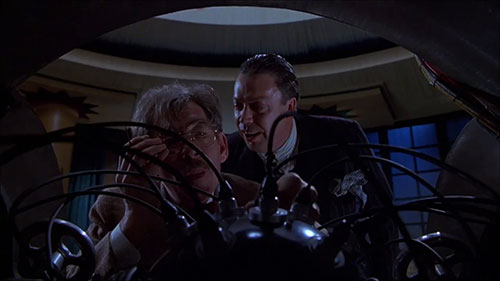 |
As Mulcahy marvels, a lot of people who didn’t necessarily need to take a small roles in a superhero movie signed up anyway: Ian McKellen, Peter Boyle, Jonathan Winters, Tim Curry, Andre Gregrory and others. Tim Curry even gets to go insane by the end, and that’s never not fun.
5. Penelope Ann Miller is Easy on the Eyes.
 |
She wears lots of slinky and/or shiny gowns, if you’re into that sort of thing. But more importantly, her character Margo Lane (who, being mildly telepathic, is immune to the Shadow’s Jedi mind tricks) never devolves into a distressed damsel, and she plays a big part in the saving of the day. While Miller cracks ever so slightly under an exposition-dump in the third act, she and Baldwin are terrific verbal sparring partners, because –
6. It’s a Screwball Comedy.
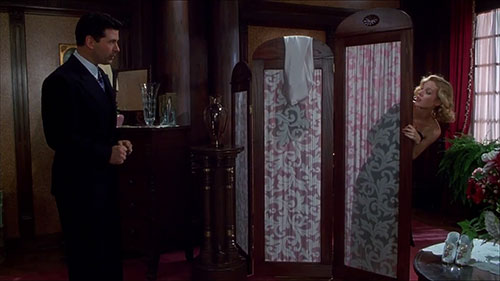 |
Bringing Up Baby it ain’t, but The Shadow is also intentionally very funny, though never at the expense of the material. And a lot of that comes from Baldwin and Miller digging into David Koepp’s script, which pays homage to movies like His Girl Friday and The Thin Man. Trust me, that’s a good thing.
Also, Jonathan Winters.
 |
RIP.
7. If You Like It, There’s a Lot More Where That Came From.
Not of the movie itself, mind you; as probably goes without saying, the 1994 version The Shadow was not the franchise-starter that Universal was surely hoping for. But many of the radio shows are still available, the best of which are from the year that Orson Welles played the lead. His final episode of The Shadow was about a month and half before his famous War of the Worlds broadcast on his own Mercury Theater on the Air series, which gives you a sense of where his head was at while he was playing Lamont Cranston.
Right around at the time that Orson Welles took the role on the air in 1937, a B-picture called The Shadow Strikes was released, starring Rod La Rocque. Like most no-budget crime pictures in those days, it has lots of guys in suits and hats standing around talking, and Rod La Rocque was no Orson Welles.
Embedding has been disabled by request on the the Shadow serial from 1940. Again, it’s not really “good” unless you were born in 1933 and are seeing it in theater during its first run, but it still has a goofy, dingy charm.
And after American gave Fritz the what-for World War II, who else besides Johnny came marching home? The Shadow, that’s who, played by Kane Richmond in 1946’s The Shadow Returns.
But the best time The Shadow returned – and the only time anyone came close to being as suave as Orson Welles – was when he was played by Alec Baldwin, and it’s now available from Shout! Factory. Check it out.
Previously by Sherilyn Connelly:
The 33 Coolest Videos from PONIES: The Anthology
The 5 Coolest Things About the Navajo Translation of Star Wars
The Nineteen Coolest Illustrations from Star Trek Fanzines
The 9 Coolest Sci-Fi Read-Along Records from the 70s and 80s
15 Awesomely Nerdy Behind-the-Scenes Documentaries You Can Watch for Free Right Now
The Eight Funniest Recurring Themes in the Original Star Wars Trading Cards
The Six Coolest Things In Starlog #001: The Voyage in Retro-Nerdery Begins
